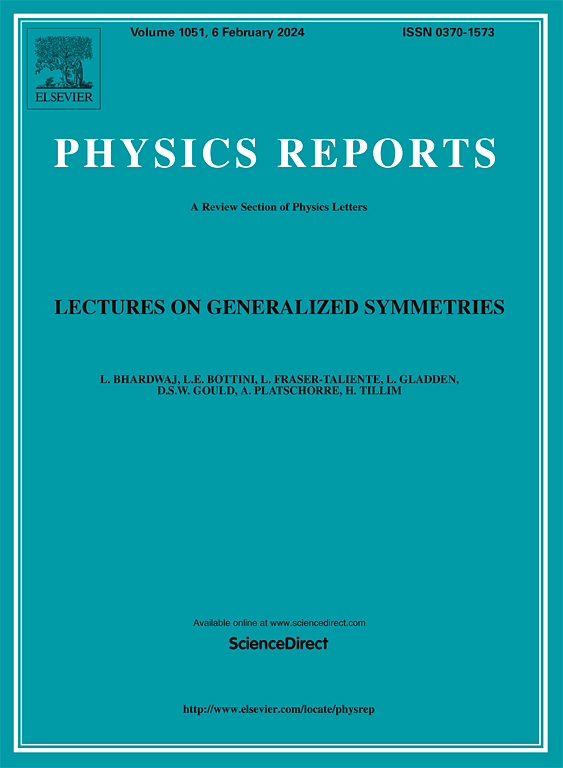Subharmonic modulational instabilities
IF 29.5
1区 物理与天体物理
Q1 PHYSICS, MULTIDISCIPLINARY
引用次数: 0
Abstract
Benjamin and Feir in 1967 demonstrated that Stokes waves in deep water are unstable against longitudinal sideband perturbations, and this instability leads to the transformation of an initial periodic wave train into a chain of wave packets. Nowadays, this phenomenon is known as the Benjamin–Feir or modulational instability (MI), with a more general definition. In particular, it may be the subharmonic instability, when periodic wave trains are unstable against perturbations whose spatial period is a multiple of the underlying wave-train’s period. MI is well known as a ubiquitous effect occurring in diverse fields, such as water waves, plasmas, optics and photonics, and Bose–Einstein condensates (BECs). One can examine the initial (i.e., linear) stage of the MI development by the linearization of the governing equations for small perturbations around the initial (unperturbed) periodic wave train. The linearization ceases to be valid when the growing amplitude of the perturbations becomes comparable to the amplitude of the unperturbed periodic wave trains, which makes investigation of the nonlinear stage of the MI-driven dynamics necessary. It is well known that the nonlinear evolution of MI leads to the formation of localized structures, such as solitons, breathers and rogue waves (RWs). Another essential type of the instability is the high-frequency MI (HFMI), which also originates from the water-wave theory and has been extended to other fields of physics. Similar to the classical MI (alias the low-frequency MI (LFMI)), HFMI may also be viewed as a subharmonic instability of periodic wave trains, but with a very small growth rate and narrow intervals of the Floquet exponents in which HFMI occurs. In this review, we mainly focus on the linear and nonlinear dynamics of periodic wave trains in integrable and nearly integrable systems, including the linear and nonlinear stage of the MI development and investigation of the subharmonic MI. First, we review findings concerning HFMI in fluid dynamics. Subsequently, we address outcomes of HFMI in various physical fields produced by the universal nonlinear Schrödinger (NLS) equation, complemented by a spatially periodic potential. Second, we review discoveries regarding MI of cnoidal waves in nearly integrable and non-integrable systems, drawing insights from the consideration of the long-wave-short-wave resonance equation and universal equation. In addition to that, we summarize analytical results pertaining to MI and modulational stability of cnoidal waves in some integrable systems. Third, we review results for the nonlinear stage of the MI development, by introducing exact correspondence between MI and the formation of localized waves, including RWs with ultra-high peak amplitudes in the baseband-MI regime, and the formation of RWs in the zero-wavenumber-gain MI regime, in the framework of the three-component Gross–Pitaevskii equations, Bers–Kaup–Reiman system, Lugiato–Lefever equations and nonlinear Dirac equations.
次谐波调制不稳定性
Benjamin和Feir(1967)证明了深水中的Stokes波在纵向边带扰动下是不稳定的,这种不稳定性导致初始周期波列转变为波包链。如今,这种现象被称为Benjamin-Feir或调制不稳定性(MI),具有更一般的定义。特别是,当周期波列在空间周期为底层波列周期的倍数的扰动下不稳定时,它可能是次谐波不稳定。众所周知,MI是一种普遍存在的效应,发生在不同的领域,如水波,等离子体,光学和光子学,以及玻色-爱因斯坦凝聚体(BECs)。人们可以通过对初始(未扰动)周期波列周围的小扰动的控制方程的线性化来检查MI发展的初始(即线性)阶段。当扰动的增长幅度与未扰动的周期波列的幅度相当时,线性化就失效了,这就需要对mi驱动动力学的非线性阶段进行研究。众所周知,MI的非线性演化导致局部结构的形成,如孤子、呼吸子和异常波(RWs)。另一种重要的不稳定性类型是高频失稳(HFMI),它也起源于水波理论,并已扩展到物理学的其他领域。与经典MI(又称低频MI (LFMI))类似,HFMI也可以被视为周期性波列的次谐波不稳定性,但HFMI发生时的Floquet指数的增长率非常小,间隔也很窄。本文主要介绍了可积和近可积系统中周期波列的线性和非线性动力学,包括广义广义波列的线性和非线性发展阶段以及次谐波广义波列的研究。随后,我们讨论了由通用非线性Schrödinger (NLS)方程产生的各种物理领域的HFMI结果,并辅以空间周期势。其次,我们回顾了近可积和不可积系统中关于余弦波的MI的发现,并从长波-短波共振方程和通用的ϕ4方程中获得了启示。此外,我们还总结了一些可积系统中关于MI和余弦波调制稳定性的分析结果。第三,在三分量Gross-Pitaevskii方程、bers - kap - reiman系统、Lugiato-Lefever方程和非线性Dirac方程的框架下,通过引入MI与局域波的形成之间的精确对应关系,回顾了MI发展的非线性阶段的结果,包括基带MI区域中具有超高峰值振幅的RWs,以及零波数增益MI区域中RWs的形成。
本文章由计算机程序翻译,如有差异,请以英文原文为准。
求助全文
约1分钟内获得全文
求助全文
来源期刊

Physics Reports
物理-物理:综合
CiteScore
56.10
自引率
0.70%
发文量
102
审稿时长
9.1 weeks
期刊介绍:
Physics Reports keeps the active physicist up-to-date on developments in a wide range of topics by publishing timely reviews which are more extensive than just literature surveys but normally less than a full monograph. Each report deals with one specific subject and is generally published in a separate volume. These reviews are specialist in nature but contain enough introductory material to make the main points intelligible to a non-specialist. The reader will not only be able to distinguish important developments and trends in physics but will also find a sufficient number of references to the original literature.
 求助内容:
求助内容: 应助结果提醒方式:
应助结果提醒方式:


